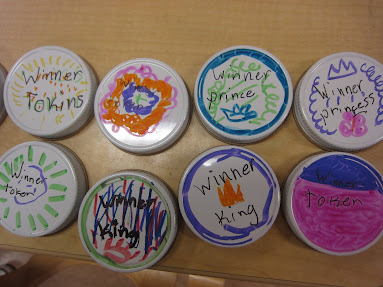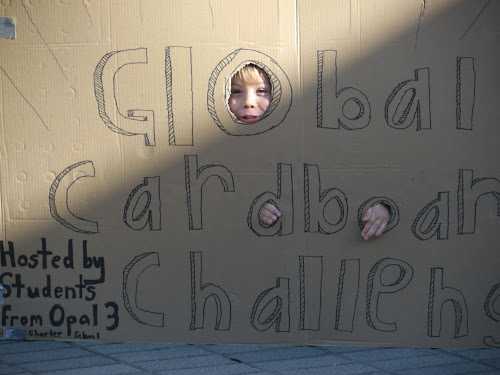Exploring Cardboard, Part 2
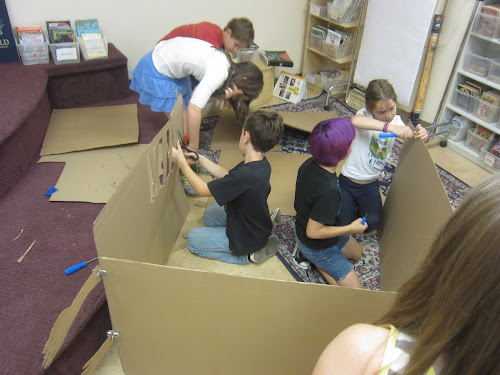
The Global Cardboard Challenge was just five days away. On Monday, October 1st, Opal 3 students set off on the arduous task of not only planning an event that would occur very publicly in front of the Portland Children's Museum the following Saturday, but also becoming the main designers of the exhibit.
"How can we create an environment that will both encourage people to play and build with cardboard?" I asked. To make things a little tougher and hopefully spur their creativity I threw in an additional caveat: "It can't be a cardboard arcade like Caine's. You have to design something new and unique."
I threw the students this "ball" with the intention of letting them take it where they wanted to go. But to make sure that they had somewhere they could go, I knew I had to provide them with enough materials and time for their ideas to take root and begin to bear fruit. From the previous weeks' experience, I knew that cardboard wasn't the easiest of materials to master. It wasn't always easy to cut, fold or build with. Plus, the students hadn't had nearly the time to find its affordances as they have had with materials such as paint or clay. Admittedly, I was concerned that five days wouldn't be enough time to produce the quality of creations that might inspire others. Nonetheless, I felt hopeful that this group would be up to the challenge. I had spent the weekend acquiring large amounts of high quality flat cardboard and boxes from a local brewery as well as bags of items such as bottle caps, plastic lids, corks, plastic tubes, cardboard rivets and rubber bands so they had enough materials to build their creations. I also was committing much of the week in class to allow for the creative process to unfold. How would it unfold? I wondered how this project, with its clear deadline and defined material, would bring our classroom together: Would it's tight timeframe stress kids out or would the class support each other to assure we accomplished our task?
With materials in hand and a question to grapple with, the class set about diving into the work. Some students joined together in small groups and pairs, while others preferred solitary work.
 |
| A group decided to follow a "haunted" theme and began to create a haunted jail. |
 |
| D. chose to work alone on a small scale creation |
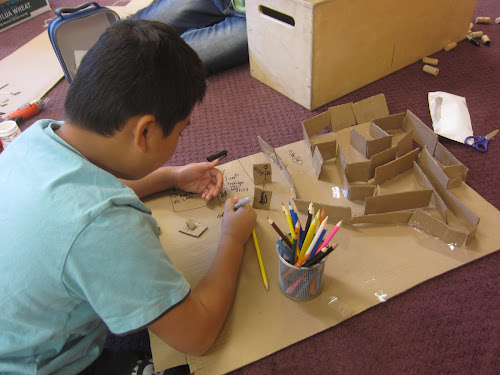 |
| E. created an interactive game board inspired by a video game he plays. |
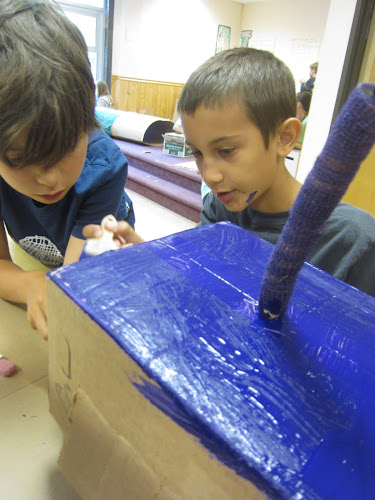 |
| M. And S. explored the use of boxes to make costumes like this purple robot. |
While most of the students focused on individual projects and designs, a few of the students began to wonder about a larger theme.
Sylvie: What if we did something based on the book we're reading…
Annika:…The Phantom Tollbooth…
Lauren: We could make a tollbooth that everyone had to get tokens from and when you went around to all the games you would use them to play.
Sylvite: Then maybe when you finished you could get prizes or something…
Lauren: Different parts of the room could be called different things like The Doldrums.
This thematic idea was brought to the class. While there wasn't agreement about having a theme for the whole event, there was a lot of interest in the creation of the tollbooth and the use of tokens. Students started adding these ideas to their own creations.
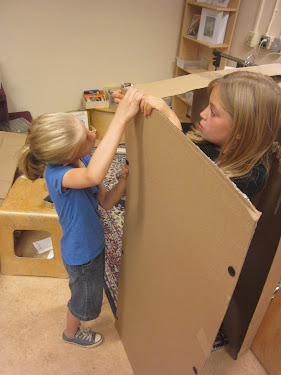 |
| Figuring out how to make the tollbooth stand. |
 |
| A large group worked on the production of tokens. |
 |
| B. adding a token and game component to the haunted jail. |
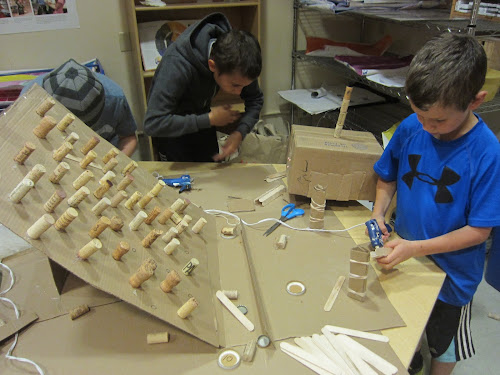 |
| You could use tokens to play A.'s pinball game |
The tokens, and the prizes that soon followed, created a connection between many of the projects – but I wasn't sure if it actually brought the class together. Sure, they were sharing an idea and incorporating it into the work they were doing, but I couldn't really say if this was enough to create that feeling of "togetherness", that feeling that "we are all in this together." The addition of the tokens did, however, spur innovation and changes to the creations that some students were making. As the week moved along, the students displayed little stress about the impending deadline and, in fact, seemed to settle into the designing and building easier by Thursday and Friday.
By Friday, the class was prepared and excited to share their work with the rest of Portland. About three quarters of the kids had committed to attending with their parents at some point over the three hour Global Challenge and we talked about the kinds of jobs they thought were needed. We realized that some people would have to inform the public about what we were doing, some would help run the various games and some would help others build and create. Each "host" would wear a black Children's Museum apron so they could be identified.
On Saturday, students showed up and helped set up the space before we opened for business. Throughout the day they were brilliant hosts, taking great pride in both sharing their work and helping visitors play with cardboard.
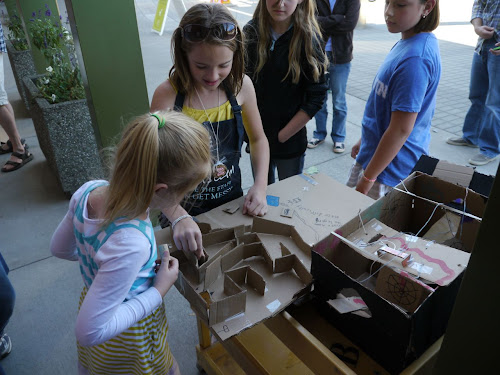 |
| I. Helping kids explore the maze game. |
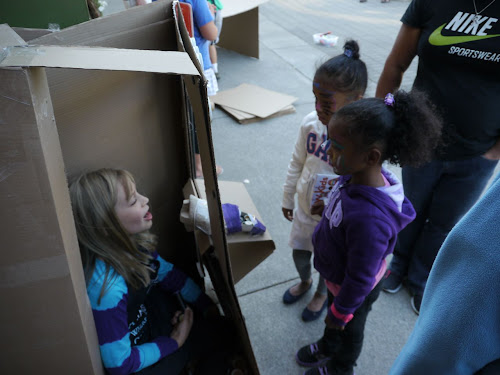 |
| Welcoming visitors from the tollbooth |
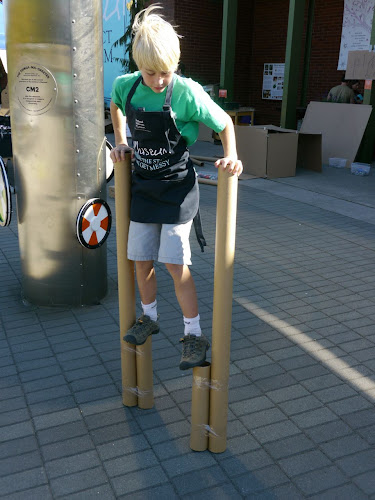 |
| Playing with some recently made stilts |
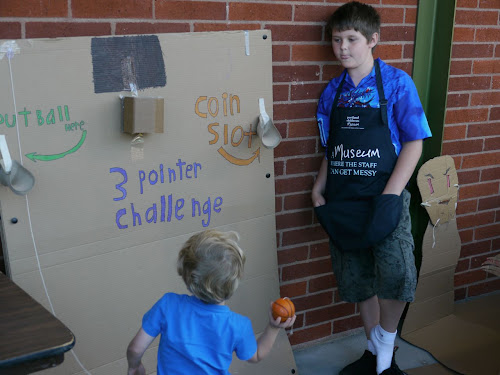 |
| Helping a young visitor play a game |
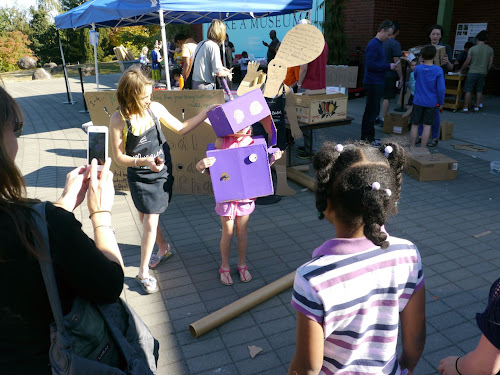 |
| Helping visitors play with cardboard creations. |

